1993 CADILLAC SEVILLE tires
[x] Cancel search: tiresPage 9 of 407

Downloaded from www.Manualslib.com manuals search engine For the 1948 model, Cadillac
introduced
the
which set the trend in autonlotive
styling for nearly
two decades. This
was followed by the 1949 model with
the two door hardtop Coupe DeVille
and
the modern overhead valve,
high compression
V8 engine.
Engineering innovations, con-
veniences and styling dominated the
'50s and '60s. Cruise control, auto-
matic climate control,
tilt and
telescoping steering wheels, twilight
sentinel and four door hard tops all
debuted in these years. In
1957 the
Eldorado Brougham featured ad-
vances such as air suspension, mem-
ory seat, automatic electric door
locks, transistor radio,
a brushed stainless steel
roof and
low profile
tires.
r' , The .. . . : ... . ...,:
t prado,l introduced in
1953, was redesigned for 1967 as the
first front wheel drive personal lux-
ury car.
The 472 cu. in. V8 engine
used in all Cadillacs in
1968 and
1969 was enlarged to 500 cu. in. for
all 1970 Eldorados.
An Air Cushion Restraint Sys-
tem (airbag) was available for 1974,
1975 and
1976 Cadillacs.
Analog Electronic Fuel Injec-
tion was available, on
1975 Cadillacs
and was standard on the new inter-
national size
7976 Seville. In 1978,
the Trip Computer option incor-
porated an on-board microprocessor.
1957 Eldorado Brougham
Page 137 of 407
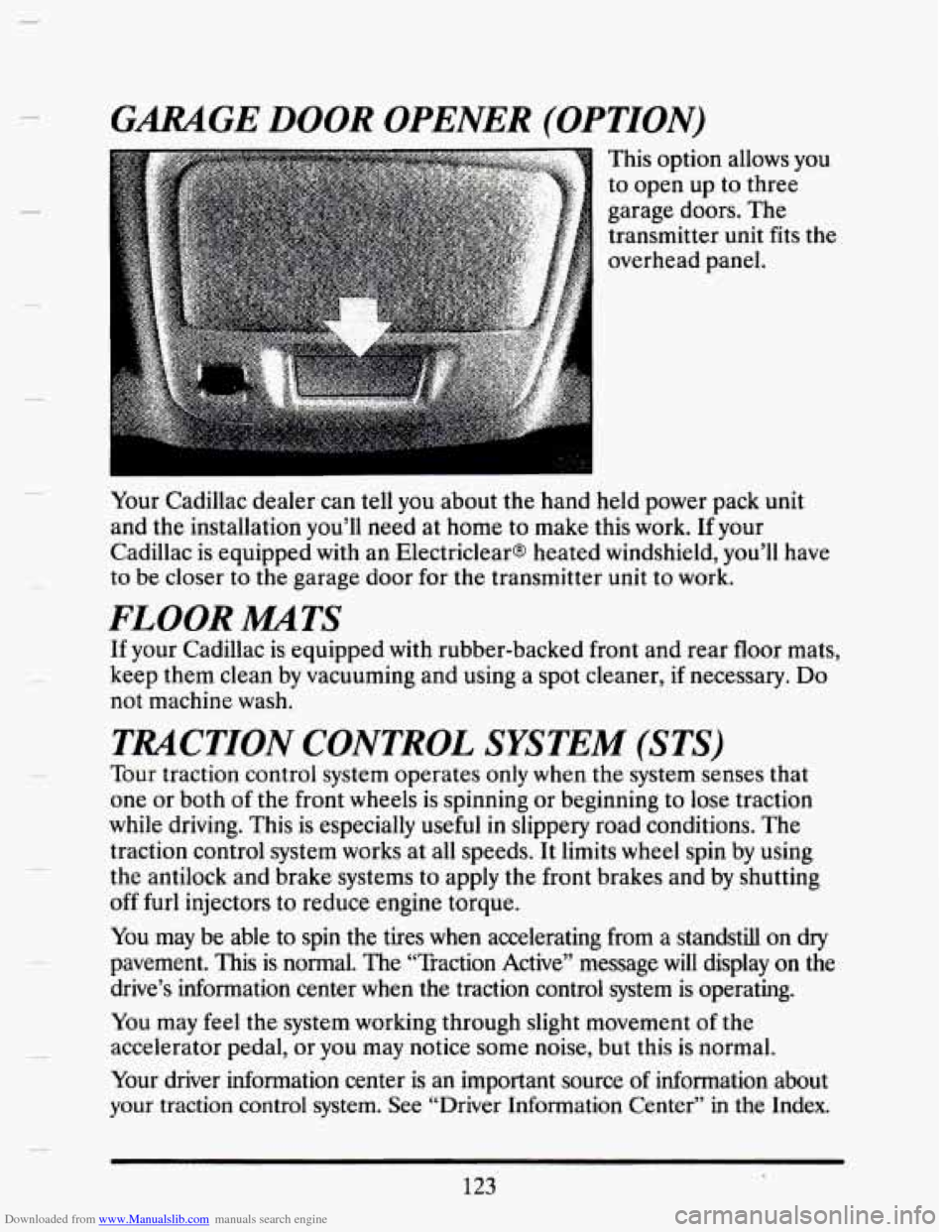
Downloaded from www.Manualslib.com manuals search engine GARAGE DOOR OPENER (OPTION)
This option allows you
to open up to three
garage doors. The
transmitter unit fits the
overhead panel.
Your Cadillac dealer can tell you about the hand held power pack unit
and the installation you’ll need at home to make this work. If your
Cadillac is equipped with an Electriclears heated windshield,
you’ll have
to be closer to the garage door for the transmitter unit to work.
FLOOR MATS
If your Cadillac is equipped with rubber-backed front and rear floor mats,
keep them clean by vacuuming and using a spot cleaner,
if necessary. Do
not machine wash.
TRACTION CONTROL SYSTEM (STS)
Tour traction control system operates only when the system senses that
one or both
of the front wheels is spinning or beginning to lose traction
while driving. This is especially useful
in slippery road conditions. The
traction control system works at all speeds. It limits wheel spin
by using
the antilock and brake systems
to apply the front brakes and by shutting
off furl injectors to reduce engine torque.
You may be able to spin the tires when accelerating from a standstill on
dry
pavement. This is normal. The “Traction Active” message will display on the
drive’s information center when the traction control system is operating.
You may feel the system working through slight movement
of the
accelerator pedal, or you may notice some noise, but this is normal.
Your driver information center is an important source
of information about
your traction control system. See “Driver Information Center” in the Index.
123
Page 192 of 407
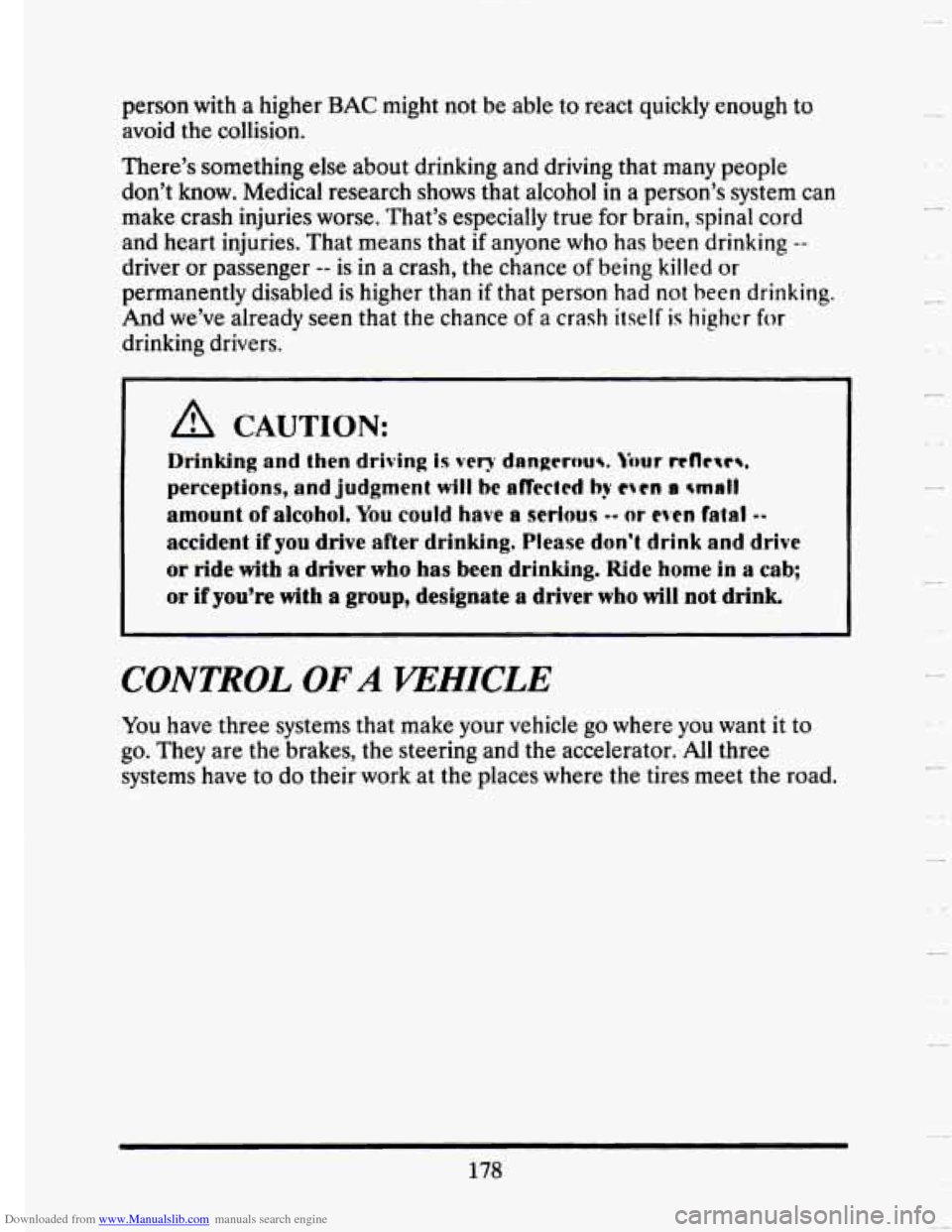
Downloaded from www.Manualslib.com manuals search engine person with a higher BAC might not be able to react quickly enough to
avoid the collision.
There’s something else about drinking and driving that many people
don’t know. Medical research shows that alcohol
in a person’s system can
make crash injuries worse. That’s especially true for brain, spinal cord
and heart injuries. That means that
if anyone who has been drinking --
driver or passenger -- is in a crash, the chance of being killed or
permanently disabled is higher than if that person had not been drinking.
And we’ve already seen that the chance of a crash itself is higher for
drinking drivers.
A CAUTION:
Drinking and then driving is very dangeroucr. hur rt(lrw%.
perceptions, and judgment will be aNecled by even a smrl?
amount of alcohol. You could have a serious -- or even fatal --
accident if you drive after drinking. Please don’t drink and drive
or ride with a driver who has been drinking. Ride home in a cab;
or if you’re with a group, designate a driver who will not drink.
CONTROL OF A PEHICLE
You have three systems that make your vehicle go where you want it to
go. They are the brakes, the steering and the accelerator. All three
systems have to do their work at
the places where the tires meet the road.
178
Page 193 of 407
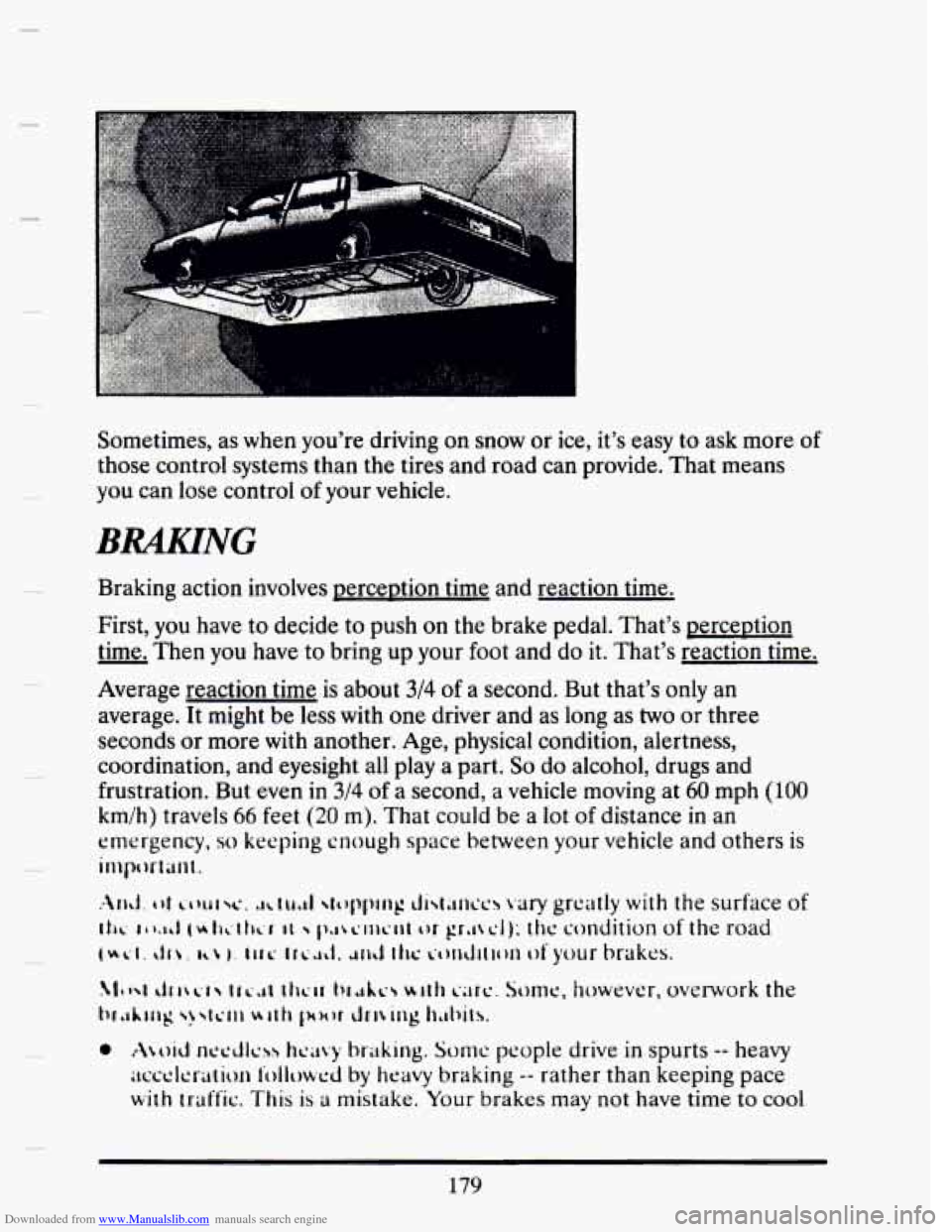
Downloaded from www.Manualslib.com manuals search engine Sometimes, as when you're driving on snow or ice, it's easy to ask more of
those control systems than the tires and road can provide. That means
you can lose control of your vehicle.
Braking action involves perceDtion time and reaction time.
First, you have to decide to push
on the brake pedal. That's perceDtion
- time. Then you have to bring up your foot and do it. That's reaction time.
Average reaction time is about
3/4 of a second. But that's only an
average. It might be less with one driver and
as long as two or three
seconds or more with another. Age, physical condition, alertness,
coordination, and eyesight
all play a part. So do alcohol, drugs and
frustration. But even in
3/4 of a second, a vehicle moving at 60 mph (100
km/h) travels 66 feet (20 m). That could be a lot of distance in an
emergency,
so keeping cnough space between your vehicle and others is
impclrtmt.
.hJ. ot LAWN*. .ILIU.II qqwg di\l,mccb vary grcatly with the surface of
IIK IO.^ (ut~ilt~k~l II pai~-ll~~*l~t or gr,t\cl); the condition of the road
(UL'I. dr?, ~i) ). IIIC 1rc.d. JI~ ttrc LX~~I~IOII of your brakes.
0 ALclid nccdlchs hca\y braking. Somc: people drive in spurts -- heavy
acceleration followed by heavy braking -- rather than keeping pace
with traffic. This is a mistake. Your brakes may not have time to cool
179
Page 199 of 407
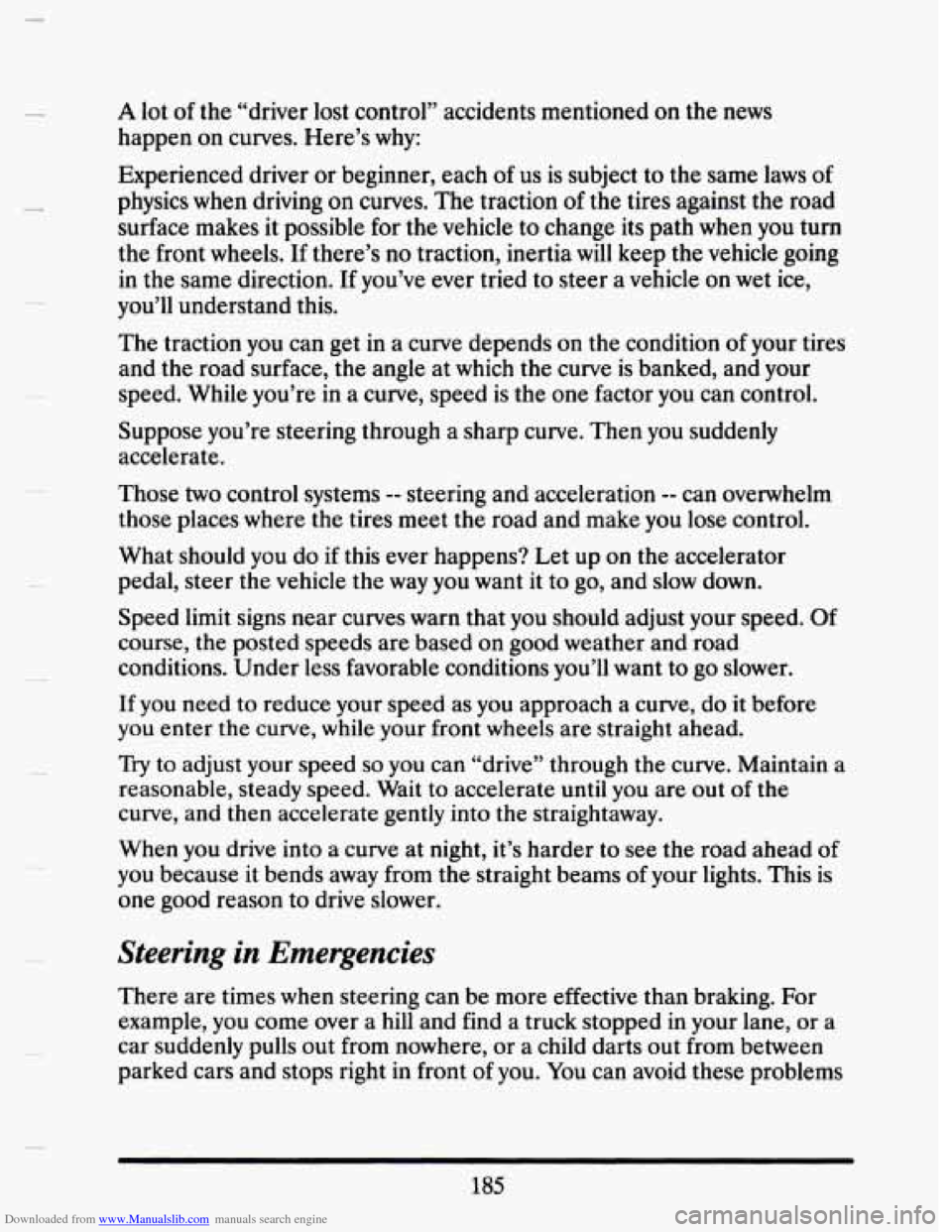
Downloaded from www.Manualslib.com manuals search engine A lot of the “driver lost control” accidents mentioned on the news
happen on curves. Here’s
why:
Experienced driver or beginner, each of us is subject to the same laws of
physics when driving on curves. The traction of the tires against the road
surface makes it possible for the vehicle to change its path
when you turn
the front wheels.
If there’s no traction, inertia will keep the vehicle going
in the same direction. If you’ve ever tried to steer a vehicle on wet ice,
you’ll understand this.
The traction
you can get in a curve depends on the condition of your tires
and the road surface, the angle at which the curve is banked, and your
speed. While you’re in a curve, speed is the one factor you can control.
Suppose you’re steering through a sharp curve. Then you suddenly
accelerate.
Those
two control systems -- steering and acceleration -- can overwhelm
those places where the tires meet the road and make you lose control.
What should you do
if this ever happens? Let up on the accelerator
pedal, steer the vehicle the
way you want it to go, and slow down.
Speed
limit signs near curves warn that you should adjust your speed. Of
course, the posted speeds are based on good weather and road
conditions. Under less favorable conditions you’ll want to
go slower.
If you need to reduce your speed as you approach a curve, do it before
you enter the curve, while your front wheels are straight ahead.
Try to adjust your speed so you can “drive” through the curve. Maintain a
reasonable, steady speed. Wait to accelerate
until you are out of the
curve, and then accelerate gently into the straightaway.
When you drive into a curve at night, it’s harder to see the road ahead of
you because
it bends away from the straight beams of your lights. This is
one good reason to drive slower.
Steering in Emergencies
There are times when steering can be more effective than braking. For
example, you come over a
hill and find a truck stopped in your lane, or a
car suddenly pulls out from nowhere,
or a child darts out from between
parked cars and stops right
in front of you. You can avoid these problems
185
Page 203 of 407
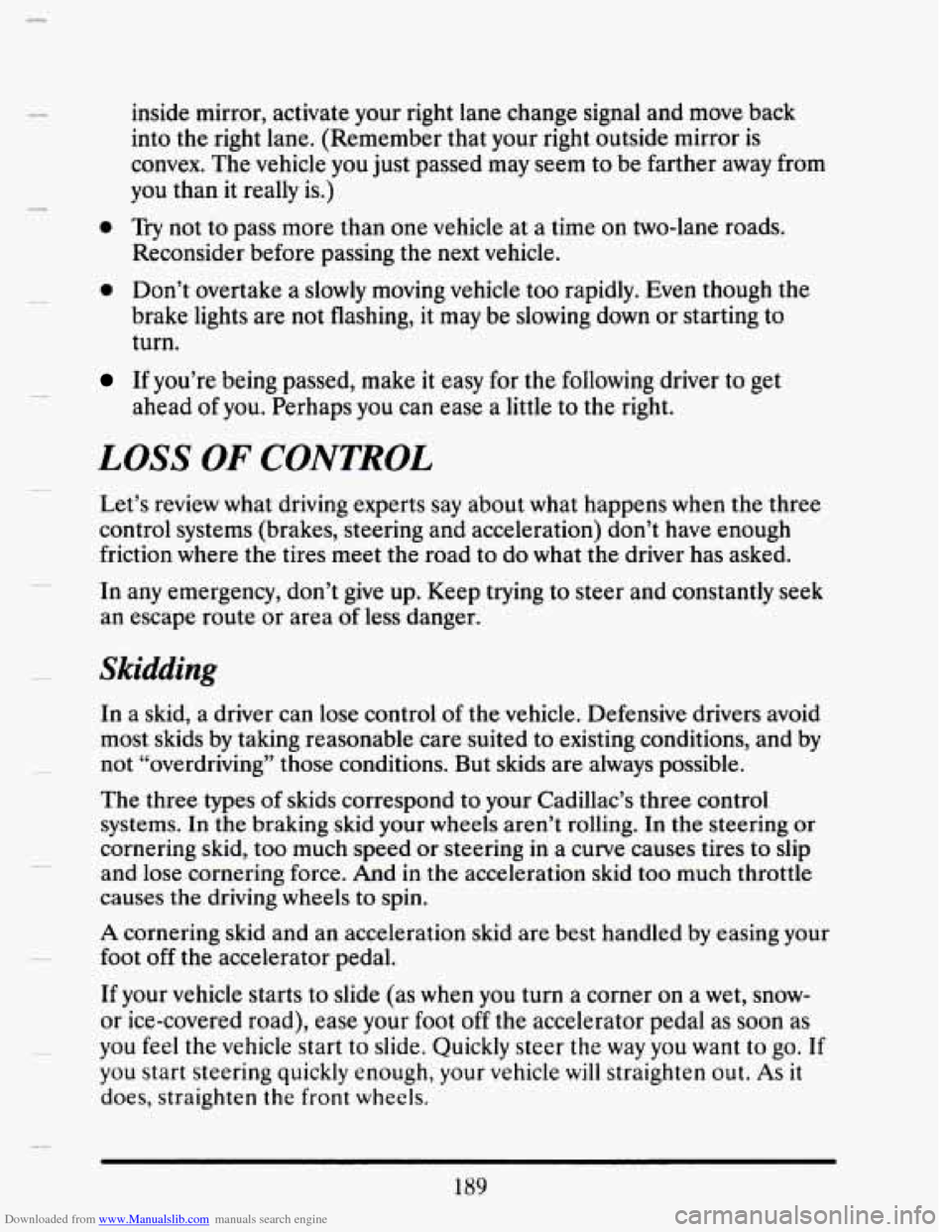
Downloaded from www.Manualslib.com manuals search engine inside mirror, activate your right lane change signal and move back
into the right lane. (Remember that your right outside mirror is
convex. The vehicle you just passed may seem
to be farther away from
you than it really is.)
0 Try not to pass more than one vehicle at a time on two-lane roads.
Reconsider before passing
the next vehicle.
0 Don’t overtake a slowly moving vehicle too rapidly. Even though the
brake lights are not flashing,
it may be slowing down or starting to
turn.
If you’re being passed, make it easy for the following driver to get
ahead
of you. Perhaps you can ease a little to the right.
LOSS OF CONTROL
Let’s review what driving experts say about what happens when the three
control systems (brakes, steering and acceleration) don’t have enough
friction where the tires
meet the road to do what the driver has asked.
In any emergency, don’t give up. Keep trying to steer and constantly
seek
an escape route or area of less danger.
Skidding
In a skid, a driver can lose control of the vehicle. Defensive drivers avoid
most skids by taking reasonable care suited to existing conditions, and by
not “overdriving” those conditions. But skids are always possible.
The three types of skids correspond to your Cadillac’s three control
systems. In the braking skid your
wheels aren’t rolling. In the steering or
cornering skid, too much speed or steering
in a curve causes tires to slip
and lose cornering force. And
in the acceleration skid too much throttle
causes
the driving wheels to spin.
A cornering skid and an acceleration skid are best handled by easing your
foot
off the accelerator pedal.
If your vehicle starts to slide (as when you turn a corner on a wet, snow-
or ice-covered road), ease your foot
off the accelerator pedal as soon as
you feel
the vehicle start to slide. Quickly steer the way you want to go. If
you start steering quickly enough, your vehicle will straighten out. As it
does, straighten the front wheels.
189
Page 204 of 407
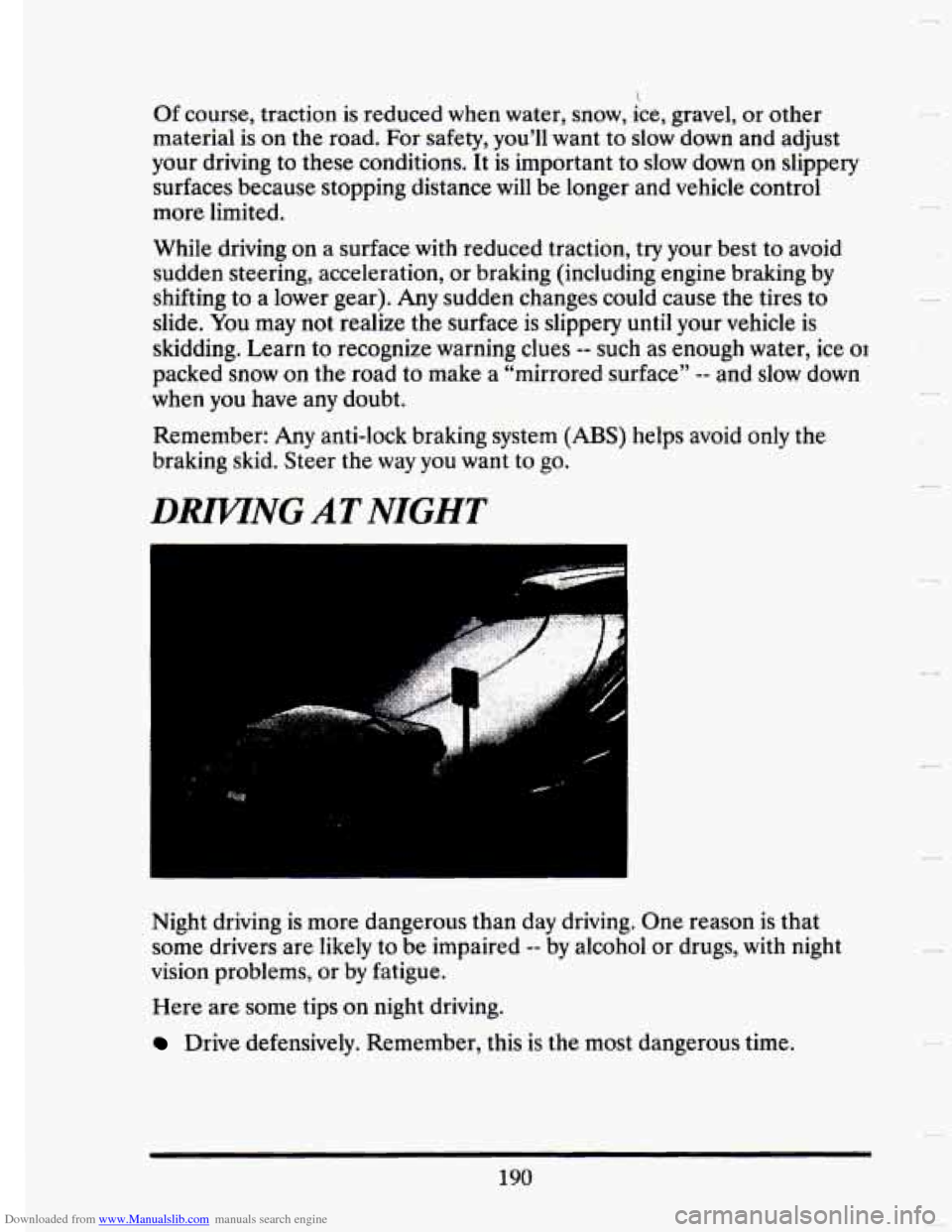
Downloaded from www.Manualslib.com manuals search engine
Of course, traction is reduced when water, snow, ice, gravel, or other
material
is on the road. For safety, you’ll want to slow down and adjust
your driving to these conditions. It is important to slow down on slippery
surfaces because stopping distance
will be longer and vehicle control
more limited.
While driving on
a surface with reduced traction, try your best to avoid
sudden steering, acceleration, or braking (including engine braking by
shifting to a lower gear).
Any sudden changes could cause the tires to
slide. You
may not realize the surface is slippery until your vehicle is
skidding. Learn to recognize warning clues
-- such as enough water, ice 01
packed snow on the road to make a “mirrored surface” -- and slow down
when
you have any doubt.
Remember: Any anti-lock braking system
(ABS) helps avoid only the
braking skid. Steer the way
you want to go.
DRM.NG AT NIGHT
Night driving is more dangerous than day driving. One reason is that
some drivers are
likely to be impaired -- by alcohol or drugs, with night
vision problems, or
by fatigue.
Here
are some tips on night driving.
Drive defensively. Remember, this is the most dangerous time.
190
I
Page 207 of 407
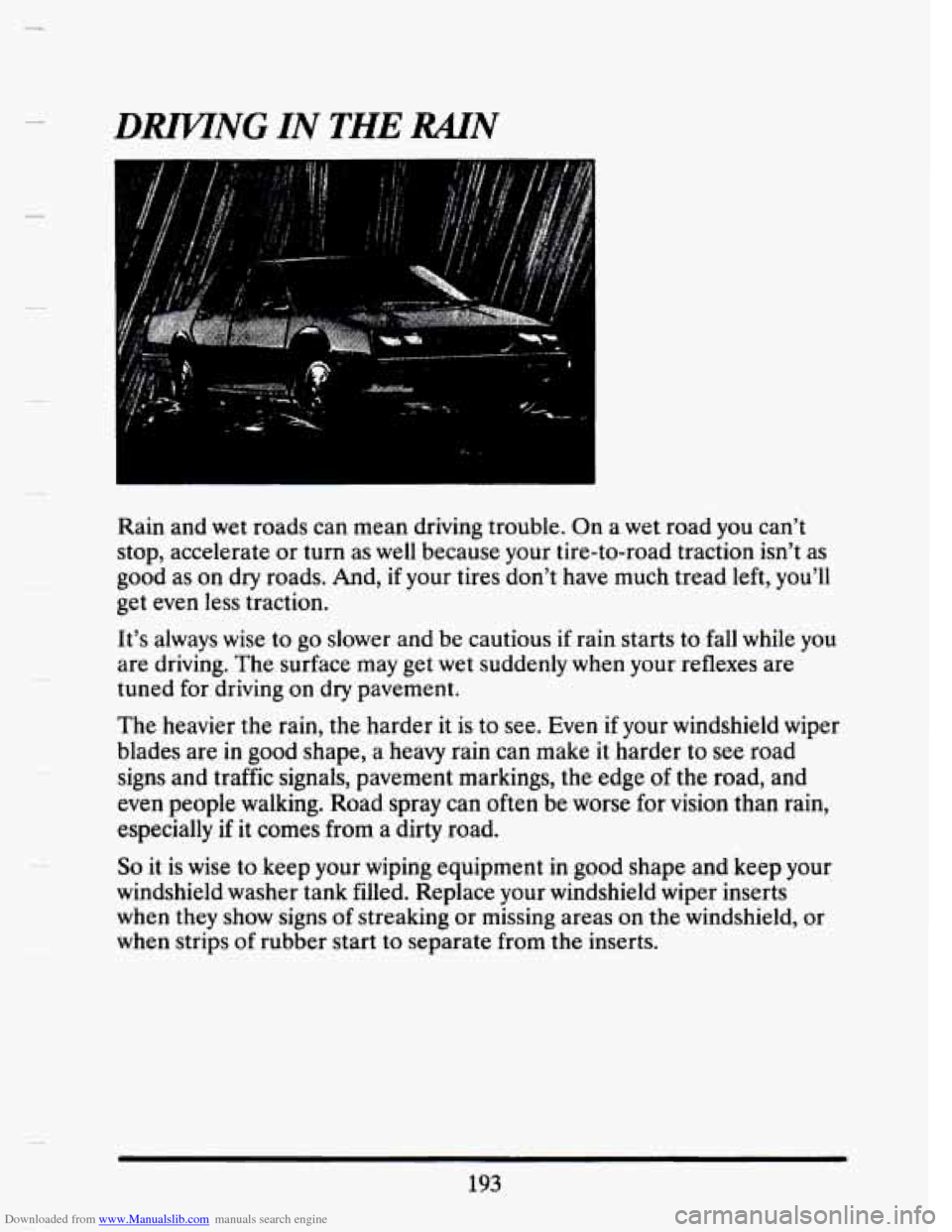
Downloaded from www.Manualslib.com manuals search engine DmNG IN THE RAIN
Rain and wet roads can mean driving trouble. On a w et road ya IU can’t
stop, accelerate or turn as well because your tire-to-road traction isn’t as
good as on dry roads. And,
if your tires don’t have much tread left, you’ll
get even less traction.
It’s always wise
to go slower and be cautious if rain starts to fall while you
are driving. The surface may get wet suddenly when your reflexes are
tuned for driving
on dry pavement.
The heavier the rain, the harder it is to see. Even if your windshield wiper
blades are
in good shape, a heavy rain can make it harder to see road
signs and traffic signals, pavement markings, the edge
of the road, and
even people walking. Road spray can often be worse for vision than rain,
especially if it comes from a dirty road.
So it is wise to keep your wiping equipment in good shape and keep your
windshield washer tank filled. Replace your windshield wiper inserts
when they show signs of streaking or missing areas on the windshield, or
when strips
of rubber start to separate from the inserts.
193